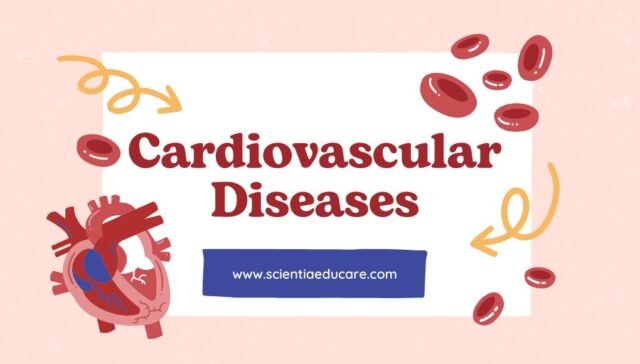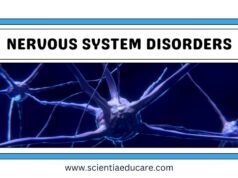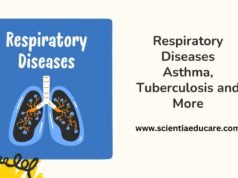Cardiovascular Diseases: Types, Causes and Prevention
Introduction
Cardiovascular diseases (CVDs) are a group of disorders that affect the heart and blood vessels. These diseases are among the leading causes of death worldwide, with millions of people affected each year. The good news is that most cardiovascular diseases are preventable. By understanding the different types of cardiovascular diseases, their causes, and how they can be prevented, individuals can take proactive steps to maintain a healthy heart and blood vessels.
Natural ways to prevent heart disease,
Understanding cardiovascular disease prevention,
Types of heart disease symptoms,
Low-cost heart disease prevention methods,
Effective heart health tips for adults
This study module aims to provide an in-depth understanding of cardiovascular diseases, their types, causes, and prevention methods.
Types of Cardiovascular Diseases
Cardiovascular diseases can be broadly categorized into various types based on the affected areas of the heart or blood vessels. The most common types include:
1. Coronary Artery Disease (CAD)
- Description: CAD occurs when the blood vessels supplying blood to the heart become narrow or blocked due to plaque buildup (atherosclerosis).
- Symptoms: Chest pain (angina), shortness of breath, and fatigue.
- Treatment: Lifestyle changes, medications, and, in some cases, surgery (e.g., angioplasty or coronary artery bypass surgery).
2. Heart Attack (Myocardial Infarction)
- Description: A heart attack happens when the blood flow to a part of the heart is blocked for an extended period, causing damage to the heart muscle.
- Symptoms: Severe chest pain, pain radiating to the arm or jaw, nausea, sweating, and dizziness.
- Prevention: Maintaining a healthy lifestyle, managing stress, and taking prescribed medications can reduce the risk.
3. Stroke
- Description: A stroke occurs when the blood supply to the brain is interrupted or reduced, leading to brain cell damage.
- Types: Ischemic stroke (due to blood clot) and hemorrhagic stroke (due to bleeding).
- Symptoms: Sudden numbness, weakness, difficulty speaking, and vision problems.
- Treatment: Immediate medical attention is required for stroke management. Long-term rehabilitation may also be needed.
4. Hypertension (High Blood Pressure)
- Description: Hypertension is when the blood pressure in the arteries is consistently high, putting strain on the heart and blood vessels.
- Risks: Hypertension can lead to heart attacks, strokes, kidney damage, and other complications.
- Treatment: Medications and lifestyle modifications, including diet and exercise, can help control blood pressure.
5. Heart Failure
- Description: Heart failure occurs when the heart is unable to pump blood effectively to meet the body’s needs.
- Symptoms: Fatigue, shortness of breath, swelling in the legs, and rapid heartbeat.
- Management: Medications, lifestyle changes, and sometimes surgery (e.g., heart transplant or heart pump).
6. Peripheral Artery Disease (PAD)
- Description: PAD involves the narrowing of the peripheral arteries, often in the legs, leading to reduced blood flow.
- Symptoms: Leg pain while walking, coldness in the legs or feet, and sores that don’t heal.
- Treatment: Medications, lifestyle changes, and in severe cases, surgery.
7. Arrhythmia
- Description: Arrhythmia refers to abnormal heart rhythms that can be too fast, too slow, or irregular.
- Types: Tachycardia (fast heartbeat), bradycardia (slow heartbeat), and atrial fibrillation (irregular heartbeat).
- Treatment: Medications, lifestyle changes, and procedures like pacemakers or ablation therapy.
Causes of Cardiovascular Diseases
Cardiovascular diseases can be caused by various factors, some of which are modifiable, while others are non-modifiable.
1. Modifiable Risk Factors
- Unhealthy Diet: Diets high in saturated fats, cholesterol, and sodium increase the risk of CVDs.
- Physical Inactivity: Lack of exercise weakens the heart and leads to high blood pressure, obesity, and other health issues.
- Smoking: Smoking damages blood vessels and increases the risk of heart attacks and stroke.
- Excessive Alcohol Consumption: Heavy drinking contributes to high blood pressure, heart failure, and stroke.
- Obesity: Obesity puts additional strain on the heart and increases the likelihood of developing hypertension and diabetes.
- Stress: Chronic stress can lead to high blood pressure and other unhealthy behaviors like smoking and overeating.
2. Non-Modifiable Risk Factors
- Age: The risk of cardiovascular disease increases with age.
- Gender: Men tend to develop CVDs earlier than women, though women’s risk increases after menopause.
- Family History: A family history of CVDs increases the likelihood of developing the same conditions.
- Genetics: Some genetic conditions can predispose individuals to heart disease, such as familial hypercholesterolemia (high cholesterol levels).
Prevention of Cardiovascular Diseases
Prevention plays a vital role in reducing the burden of cardiovascular diseases. Some of the effective strategies for prevention include:
1. Adopting a Heart-Healthy Diet
- Focus on Fruits and Vegetables: Aim to eat at least five servings per day to provide essential vitamins and minerals.
- Limit Saturated Fats: Replace saturated fats with healthy fats like olive oil, nuts, and seeds.
- Reduce Sodium Intake: Limiting salt can help control blood pressure.
- Include Whole Grains: Whole grains provide fiber that supports heart health.
2. Exercise Regularly
- Aim for 150 Minutes of Moderate Activity: Regular exercise strengthens the heart, reduces blood pressure, and helps maintain a healthy weight.
- Incorporate Aerobic and Strength Training: A combination of aerobic exercises (e.g., walking, running) and strength training (e.g., lifting weights) is beneficial.
3. Quit Smoking
- Seek Support and Resources: Many resources, such as smoking cessation programs and nicotine replacement therapies, are available to help individuals quit smoking.
4. Limit Alcohol Consumption
- Stick to the Guidelines: Limiting alcohol intake to moderate levels can reduce the risk of heart disease.
5. Manage Stress
- Practice Relaxation Techniques: Meditation, yoga, and deep breathing exercises can help manage stress.
- Seek Professional Support: Counseling or therapy can be beneficial for long-term stress management.
6. Regular Health Screenings
- Monitor Blood Pressure: Regular checks can help detect hypertension early.
- Check Cholesterol Levels: Regular cholesterol tests help detect high cholesterol levels, a risk factor for CVDs.
- Diabetes Management: Keep blood sugar levels in check to prevent complications such as heart disease.
Conclusion
Cardiovascular diseases are preventable through a combination of lifestyle changes, early detection, and proper management. Understanding the different types of CVDs, their causes, and preventive measures is essential in protecting your heart and maintaining overall health.
Relevant Website Links
- World Heart Federation: Cardiovascular Disease Prevention
- American Heart Association: Healthy Living
- Centers for Disease Control and Prevention (CDC) – Heart Disease
- National Institute of Health: Cardiovascular Disease Research
Further Reading
- Prevention of Cardiovascular Disease: Guidelines and Strategies
- Harvard T.H. Chan: Cardiovascular Disease Prevention
30 Multiple-Choice Questions (MCQs) on Cardiovascular Diseases: Types, Causes, and Prevention
- Which of the following is the most common cause of Coronary Artery Disease (CAD)?
- a) High blood pressure
- b) High cholesterol levels
- c) Diabetes
- d) Obesity
- Correct Answer: b) High cholesterol levels
- Explanation: High cholesterol levels cause the buildup of plaque in the arteries, leading to the narrowing and hardening of the arteries, which can result in CAD.
- What is the primary symptom of a heart attack?
- a) Headache
- b) Severe chest pain
- c) Abdominal pain
- d) Swelling in the feet
- Correct Answer: b) Severe chest pain
- Explanation: Severe chest pain is one of the most common symptoms of a heart attack, often radiating to the arms, neck, or jaw.
- Which of the following is NOT a risk factor for cardiovascular diseases?
- a) Smoking
- b) Regular physical exercise
- c) High sodium intake
- d) High cholesterol
- Correct Answer: b) Regular physical exercise
- Explanation: Regular physical exercise is a protective factor against cardiovascular diseases, reducing the risk of heart attacks and strokes.
- Which type of stroke is caused by a blocked blood vessel?
- a) Hemorrhagic stroke
- b) Ischemic stroke
- c) Transient ischemic attack
- d) Cardiogenic stroke
- Correct Answer: b) Ischemic stroke
- Explanation: Ischemic stroke is caused by a blockage in the blood vessels, leading to reduced blood flow to the brain.
- What is the normal range for a healthy blood pressure?
- a) 120/80 mmHg
- b) 140/90 mmHg
- c) 160/100 mmHg
- d) 100/60 mmHg
- Correct Answer: a) 120/80 mmHg
- Explanation: A normal blood pressure reading is generally around 120/80 mmHg. Readings higher than this may indicate hypertension.
- Which of the following is a consequence of untreated high blood pressure (hypertension)?
- a) Kidney damage
- b) Improved circulation
- c) Reduced heart function
- d) Reduced stroke risk
- Correct Answer: a) Kidney damage
- Explanation: Untreated hypertension can lead to kidney damage, as the kidneys are sensitive to high blood pressure.
- Which of the following is considered a modifiable risk factor for cardiovascular diseases?
- a) Family history
- b) Age
- c) Smoking
- d) Gender
- Correct Answer: c) Smoking
- Explanation: Smoking is a modifiable risk factor, meaning that quitting smoking can reduce the risk of cardiovascular diseases.
- Which food group is recommended to reduce the risk of cardiovascular diseases?
- a) High-fat dairy products
- b) Processed meats
- c) Fruits and vegetables
- d) Refined carbohydrates
- Correct Answer: c) Fruits and vegetables
- Explanation: A diet rich in fruits and vegetables provides vitamins, minerals, and fiber that support heart health and reduce the risk of cardiovascular diseases.
- What is a common complication of untreated peripheral artery disease (PAD)?
- a) Heart failure
- b) Gangrene
- c) Stroke
- d) Asthma
- Correct Answer: b) Gangrene
- Explanation: PAD can lead to reduced blood flow to the limbs, which, if untreated, may result in gangrene due to lack of oxygen and nutrients in the tissues.
- What is the effect of excessive alcohol consumption on cardiovascular health?
- a) Improved circulation
- b) Increased risk of high blood pressure
- c) Reduced cholesterol levels
- d) Increased heart rate
- Correct Answer: b) Increased risk of high blood pressure
- Explanation: Excessive alcohol consumption can contribute to high blood pressure, which increases the risk of heart disease and stroke.
- Which of the following is a major cause of congestive heart failure (CHF)?
- a) Diabetes
- b) Excessive salt intake
- c) Hypertension
- d) High fiber diet
- Correct Answer: c) Hypertension
- Explanation: Chronic high blood pressure puts a strain on the heart, leading to heart failure over time.
- What is the role of cholesterol in cardiovascular disease?
- a) It helps repair arteries
- b) It can lead to plaque formation in arteries
- c) It prevents heart attacks
- d) It enhances blood flow
- Correct Answer: b) It can lead to plaque formation in arteries
- Explanation: High levels of cholesterol, especially LDL (bad cholesterol), contribute to plaque buildup in the arteries, increasing the risk of heart disease.
- What is the first step in treating a heart attack?
- a) Administration of insulin
- b) Oxygen therapy
- c) Blood pressure medication
- d) Surgery
- Correct Answer: b) Oxygen therapy
- Explanation: Oxygen therapy is typically administered to patients with a heart attack to ensure adequate oxygen supply to the heart.
- Which of the following is a symptom of arrhythmia?
- a) Severe chest pain
- b) Irregular heartbeat
- c) Nausea
- d) Shortness of breath
- Correct Answer: b) Irregular heartbeat
- Explanation: Arrhythmia is characterized by an irregular or abnormal heartbeat.
- Which of the following is considered a non-modifiable risk factor for cardiovascular disease?
- a) Physical inactivity
- b) Smoking
- c) Age
- d) Poor diet
- Correct Answer: c) Age
- Explanation: Age is a non-modifiable risk factor, meaning that the risk of cardiovascular diseases increases with age.
- Which is the most effective method to prevent cardiovascular diseases?
- a) Regular exercise
- b) Taking vitamin supplements
- c) Avoiding fats
- d) High-protein diet
- Correct Answer: a) Regular exercise
- Explanation: Regular physical activity helps improve heart health, manage blood pressure, and control weight, reducing the risk of cardiovascular diseases.
- What is the purpose of angioplasty in treating heart disease?
- a) To remove cholesterol from the blood
- b) To unblock clogged arteries
- c) To reduce blood pressure
- d) To replace damaged heart valves
- Correct Answer: b) To unblock clogged arteries
- Explanation: Angioplasty is a procedure used to open up blocked or narrowed coronary arteries, restoring blood flow to the heart.
- What is the recommended amount of physical activity per week for heart health?
- a) 30 minutes per week
- b) 150 minutes per week
- c) 300 minutes per week
- d) 500 minutes per week
- Correct Answer: b) 150 minutes per week
- Explanation: It is recommended to engage in at least 150 minutes of moderate-intensity aerobic activity each week to improve cardiovascular health.
- Which condition is most likely to be caused by long-term uncontrolled hypertension?
- a) Heart failure
- b) Stroke
- c) Kidney damage
- d) All of the above
- Correct Answer: d) All of the above
- Explanation: Long-term uncontrolled hypertension can lead to heart failure, stroke, and kidney damage.
- Which of the following is a sign of a stroke?
- a) Difficulty walking
- b) Numbness on one side of the body
- c) Slurred speech
- d) All of the above
- Correct Answer: d) All of the above
- Explanation: Stroke symptoms include sudden numbness or weakness on one side of the body, difficulty walking, and slurred speech.
- Which dietary change can help lower cholesterol levels?
- a) Eating more processed sugars
- b) Consuming more trans fats
- c) Adding more fiber-rich foods
- d) Increasing salt intake
- Correct Answer: c) Adding more fiber-rich foods
- Explanation: Foods high in fiber, like fruits, vegetables, and whole grains, can help reduce cholesterol levels and improve heart health.
- Which of the following is a treatment option for high blood pressure?
- a) Diuretics
- b) Statins
- c) Painkillers
- d) Antihistamines
- Correct Answer: a) Diuretics
- Explanation: Diuretics help the body eliminate excess sodium and water, reducing blood pressure.
- Which heart disease involves the thickening and hardening of heart valves?
- a) Heart attack
- b) Heart valve disease
- c) Coronary artery disease
- d) Atrial fibrillation
- Correct Answer: b) Heart valve disease
- Explanation: Heart valve disease involves the thickening, stiffening, or leakage of the heart valves, affecting blood flow.
- **Which of the following is an effective prevention measure for cardiovascular
diseases?** – a) Eating excessive red meat
– b) Reducing salt intake
– c) Smoking regularly
– d) Increasing alcohol consumption
– Correct Answer: b) Reducing salt intake
– Explanation: Reducing salt intake helps lower blood pressure, a major risk factor for cardiovascular diseases.
- Which of the following can increase the risk of a heart attack?
- a) Regular exercise
- b) Chronic stress
- c) Low cholesterol diet
- d) Quitting smoking
- Correct Answer: b) Chronic stress
- Explanation: Chronic stress can raise blood pressure and promote unhealthy behaviors like overeating or smoking, which increase heart disease risk.
- What is the primary cause of heart failure?
- a) Atrial fibrillation
- b) Coronary artery disease
- c) High blood pressure
- d) Heart valve disease
- Correct Answer: b) Coronary artery disease
- Explanation: Coronary artery disease leads to reduced blood flow to the heart, eventually causing heart failure.
- Which type of fat is most harmful to heart health?
- a) Monounsaturated fats
- b) Polyunsaturated fats
- c) Saturated fats
- d) Omega-3 fatty acids
- Correct Answer: c) Saturated fats
- Explanation: Saturated fats can raise LDL cholesterol levels, increasing the risk of cardiovascular diseases.
- What does the term ‘atherosclerosis’ refer to?
- a) Increased heart rate
- b) Narrowing of the arteries due to plaque buildup
- c) Inflammation of the heart muscle
- d) Abnormal heart rhythms
- Correct Answer: b) Narrowing of the arteries due to plaque buildup
- Explanation: Atherosclerosis is the condition where plaque builds up in the arteries, leading to reduced blood flow and increased cardiovascular disease risk.
- What is the main goal of cardiovascular disease prevention?
- a) To lower cholesterol levels
- b) To maintain a healthy lifestyle
- c) To prevent blood clot formation
- d) To reduce blood pressure
- Correct Answer: b) To maintain a healthy lifestyle
- Explanation: Maintaining a healthy lifestyle, including regular exercise, healthy eating, and stress management, is key to preventing cardiovascular diseases.
- Which of the following can help prevent the development of high cholesterol levels?
- a) Consuming trans fats
- b) Reducing saturated fat intake
- c) Increasing sugar intake
- d) Drinking sugary beverages
- Correct Answer: b) Reducing saturated fat intake
- Explanation: Reducing the intake of saturated fats can help lower LDL cholesterol levels, reducing the risk of cardiovascular diseases.














